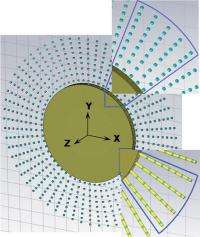June 24, 2010 feature
Researchers design more reliable invisibility cloak

(PhysOrg.com) -- Researchers have proposed a new design for an invisibility cloak - a device that could make objects invisible by guiding light around anything placed inside the cloak.
In the study, Elena Semouchkina from Michigan Technological University and Pennsylvania State University and her coauthors designed an invisibility cloak made of glass for the infrared range. Currently, most metamaterial cloak designs require that the metamaterial response be homogeneous. However, the new design relies on simulations of a true multi-element cloak structure and takes into account the inhomogeneity of a real metamaterial response.
“This is one of the first designs of an optical cloak, in particular, of a cylindrical shell,” Semouchkina told PhysOrg.com. “This is a non-metallic low-loss all-dielectric cloak. ... In contrast to the previous designs, the design of our cloak has been developed at a careful control of interactions between resonators, since a true multi-resonator structure has been simulated. It makes the design essentially more reliable.”
The structure of the proposed cloak consists of identical nanosized chalcogenide glass resonators arranged in a concentric pattern. In simulations, the researchers found that glass resonators in the shape of a cylinder with a diameter of 300 nm and a height of 150 nm provided the best results for the light wavelength of 1 micron.
“The design employs identical resonators in all layers of the cloak, which, from the point of view of fabrication tolerance, presents a tremendous advantage versus fabricating nano-sized elements of different prescribed dimensions,” Semouchkina said.
The spoke-like configuration of the resonators forms radial magnetic moments despite different incidence angles of incoming light. As Semouchkina explained, the magnetic resonance response creates the desired effective parameters of the medium.
“Our cloak is based on the magnetic resonance in dielectric resonators,” Semouchkina said. “This resonance is used to obtain the desired values of the effective permeability of the medium. The simulations of real 3D resonators, and not of effective medium layers, allowed us to find optimal resonator shapes and their arrangement to assure the magnetic moment formation in resonators illuminated under different incidence angles.”
The researchers simulated cloaked cylindrical objects of infinite lengths and of diameters ranging from 5 to 15 wavelengths. Simulations also showed that objects could be cloaked over a wide range of infrared frequencies at the manipulation of inter-resonator distances.
Overall, the new design is one more example of the progress made in invisibility cloaks since they were first designed in 2006. Since then, researchers have been working on different design approaches in an attempt to expand the cloaking spectrum, simplify fabrication, and make other improvements.
“We are currently performing detailed investigations of the interactions between the resonators in metamaterials and their role in controlling the wave propagation, as well as working on the experimental demonstration of an all-dielectric cloak operation at microwaves,” Semouchkina said.
More information: Elena Semouchkina, et al. “An infrared invisibility cloak composed of glass.” Applied Physics Letters 96, 233503 (2010). DOI:10.1063/1.3447794
Copyright 2010 PhysOrg.com.
All rights reserved. This material may not be published, broadcast, rewritten or redistributed in whole or part without the express written permission of PhysOrg.com.


















